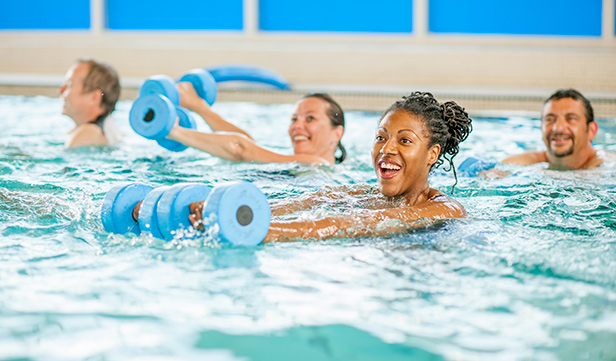
Arthritis is a disease that can affect any joint in the body, especially your knees, hips, lower back, neck, fingers, and toes. While there are more than 100 different types of arthritis, about 27 million Americans suffer from osteoarthritis (OA)—or “wear and tear” arthritis—the most common form of the condition. Arthritis can’t be reversed, but physical activity and maintaining a healthy weight can slow its progression, reduce pain, and help improve joint function.
Signs and symptoms of osteoarthritis
Osteoarthritis occurs when the protective cartilage or cushion between your bones wears down over time. This causes the bones to rub together, causing mild, moderate, or severe symptoms that may come and go. Symptoms of osteoarthritis include:
- Pain
- Swelling
- Tenderness
- Stiffness
- Loss of flexibility
As the condition progresses, you may develop bone spurs in your joints without knowing it. Bone spurs often have no symptoms, but sometimes they can cause pain and loss of motion in your joints. Bits of bone or cartilage may also break off and float inside the joint, causing more pain.
Role of exercise in managing arthritis
Treatments for osteoarthritis include losing weight, physical and occupational therapy, and medications, but exercise is one of the best ways to manage OA. In fact, physical activity is considered the most effective non-drug treatment for reducing pain and improving movement in patients with the disease.
Of course, when your joints hurt, you probably don’t want to engage in activities that may cause more pain and stiffness. But not exercising weakens your muscles and can add more stress on your joints.
How to start an arthritis exercise program
Before you start a new fitness program, ask your doctor, especially if you’re currently inactive. As long as you’re healthy enough for physical activity, the Centers for Disease Control and Prevention offers S.M.A.R.T. tips to help you exercise safely and get moving.
- Start with a small amount of activity. It may take time for your body to adjust to new activities.
- Modify your activity when you’re in pain. Try to stay active, but listen to your body.
- Activities should be joint-friendly. Choose low-impact exercises that put less stress on your body.
- Recognize safe, well-lit places to be active. Take an exercise class.
- Talk to your doctor or health professional. Find out how much and what types of activity are right for you.
Types of exercise to fight arthritis
Arthritis affects everybody in different ways. The types of exercise that may be best for you depend on your level of pain and which joints are involved. Work with your doctor or a physical therapist to create an exercise plan that’s right for you. Arthritis-friendly exercises include a wide variety of activities.
Range-of-motion exercises. The pain and stiffness of osteoarthritis can make it difficult to move your joints. Range-of-motion exercises relieve stiffness and include gentle movements that take your joints through their full span. Examples include raising your arms slowly over your head and rolling your shoulders back and forth. Doing these exercises on a regular basis can help maintain and improve the flexibility in your joints.
Flexibility exercises. Stretching, yoga, and other flexibility exercises can also be effective for people with arthritis.
Aerobic/endurance exercises. Low-impact aerobic exercises strengthen your heart, make your lungs more efficient, and give you more energy. These types of exercises can also help you burn calories and maintain a healthy weight. If you’re looking for a simple exercise that’s easy on the joints, try walking. In addition to improving your circulation, it can help tone the muscles that support your joints. Other aerobic exercises include bicycling, swimming, using an elliptical machine, and daily activities, like gardening and housework.
Water exercises. Aquatic exercises like water aerobics, performed while standing in shoulder-height water, are ideal for those who are overweight. Water relieves the pressure on your joints and provides resistance that helps strengthen your muscles.
Strengthening exercises. Strength training, weightlifting, and other strengthening exercises help build muscles that support and protect your joints. If you can’t lift weights, try working with resistance bands.
Balance exercises. Having good balance is essential for daily activities and can help improve your coordination and prevent falls. Balance exercises include walking backwards, standing on one foot, and tai chi.
Other activities. If you don’t like to exercise, don’t think of it as exercise. Just get moving. Every little bit helps. You can even exercise in a chair.
Tips to protect your joints while exercising
When you exercise, a good pair of shoes, comfortable gear, and proper techniques can help protect your joints and reduce your risk of injury. It also makes sense to take a few simple precautions.
Warm up. Start by stretching or moving your joints gently with range-of-motion exercises.
Go slowly. Exercise with gradual, easy movements.
Take breaks. Don’t overdo it. Take breaks to protect your joints.
Switch it up. Try different types of exercise. Rather than walking every day, include a variety of activities, like yoga and water aerobics.
Pace yourself. If you can carry on a conversation while exercising, you’re doing it right.
Set realistic goals. The U.S. Department of Health and Human Services recommends that adults aim for at least 150 minutes of moderate aerobic activity each week, along with two strength-training sessions. How much activity you need may be different, depending on your circumstances and your doctor’s recommendations.
Know when to stop. If you feel discomfort that is stronger than your usual joint pain—or notice swelling or redness in your joints—stop exercising. Ask your doctor about how to recognize when pain is a sign of something more serious.
Exercise benefits people with osteoarthritis
Exercise is crucial for anyone with arthritis. In addition to strengthening the muscles around your joints, physical activity can help you control your weight and maintain strong bones. People who exercise also tend to have more energy and get a better night’s sleep—which is reason enough to get moving.